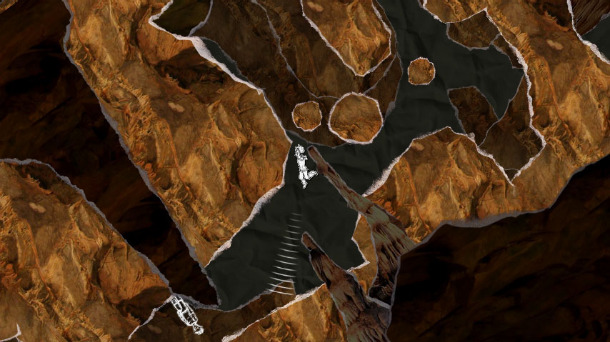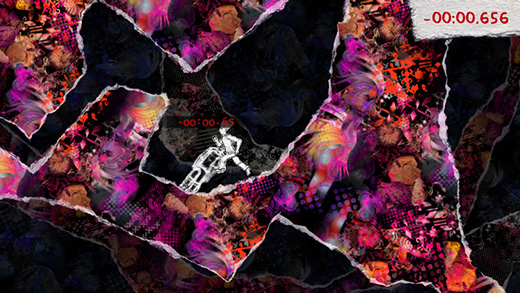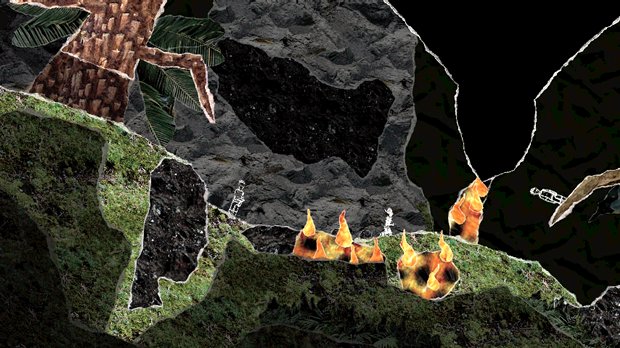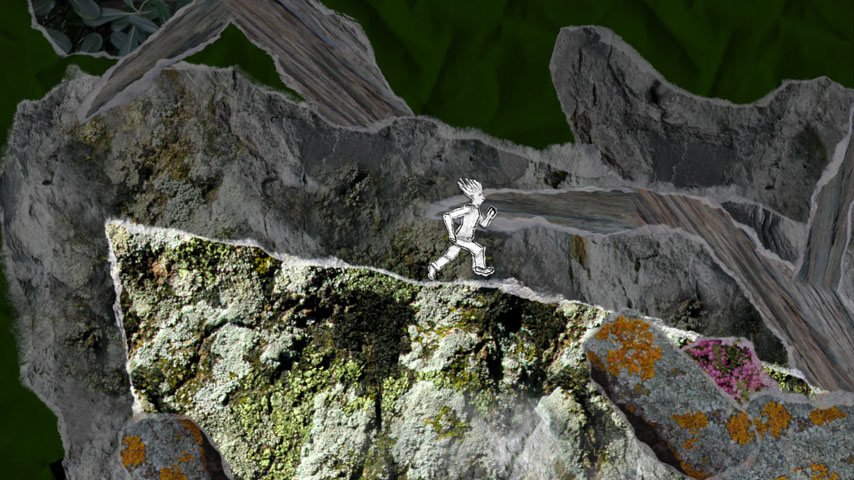From graphics to sound and gameplay to controls, one of the most unique games this year
Minor bugs such as clipping; occasional framerate issues; poor pacing
Upon entry of the introductory level of Austrian developer Broken Rules’ And Yet it Moves, the player is presented with a very short list of commands used to control the game. This is how it would read if you were playing with the standard Wii remote control scheme:
(d-pad) – run
2 – jump
At this point, had you not previously encountered the game (it was initially released on PC last year, and had been in beta years before that), it would nearly be basic instinct to abide by the instructions and jump. After all, the most basic and recognizable mechanic of any video game is a jump button, and it’s the first thing you’ll check for in anything you’re unfamiliar with. The player character meanders up some cave steps and crosses paths with another sign:
hold 1 to freeze the world
tilt to rotate

Hmm…thanks for the advice. And just as you were told, a tilt of the Wii Remote is a tilt of the game world. It’s useful, but you’d rather jump. A couple minutes pass and you’ll realize that jumping in this game isn’t that great, and presumably isn’t meant to be. Your player character constantly runs at the same pace, there’s no momentum, the platforming is not advanced by any stretch of the imagination, and the jumping animation is stiff – arms aimed at the sky as if your character is trying to reach a pull-up bar rather than a cleverly placed rock. So, jumping – no good and no fun.
And Yet it Moves is an interesting platform game in that it can be completed without using the jump button that much at all. In fact, after the first level, the game essentially feels like a free-form game of labyrinth. The object of the game is to get your man to the end of the level by rotating the world around him and dodging obstacles. There is no story or explanation as to why this paper guy is in this world, what he is doing, or why is doing it. In theory, you could make your marble jump in a traditional labyrinth board game, but it’s useless; and as I said earlier, jumping in And Yet it Moves is nearly useless too. It’s less of a jumping game than it is a falling game, as most of its challenge lies in gravitational situations, such as how far you can fall without dying, or how fast you can travel on a swing without meeting your imminent death via the obstacle standing in front of the path’s end. Furthermore, a land on a steep drop rather than a flat surface will usually break your fall and save your life. It makes for interesting risk-taking gameplay, especially in the speed run mode.

Four different control schemes can be utilized in the game. Three out of four of them use the Wii remote’s accelerometer function. Along with holding the Wii remote NES-style and tilting it like a steering wheel; you can use the classic controller with shoulder button tilts for more precise rotation. There are two variations of the remote+nunchuck scheme; one that utilizes IR controls to rotate the world via dragging, and one with tilt control similar to the Wii Remote-only scheme. I tried all control schemes with the exception of the classic controller. The Wii Remote-only scheme seems to be a bit iffy at times, and definitely the least accurate out of the four. The best control scheme I played with is the “keyhole” remote+nunchuck combo, the analog stick used to move while the d-pad of the remote can be used to rotate the world.
The game takes place in a world where everything is made of ripped paper. The player character is a paper cut out, its features distinguished by rough pencil drawings on said paper. If the player dies, his paper body is ripped into pieces. Placed around the level are silhouettes of the player character that act as checkpoints. No said checkpoints are placed more than 30 seconds away from each other, so it doesn’t become too frustrating. The environment and atmosphere of the game induce flashbacks to those construction paper and magazine collages you made in 1st grade art class. Your adventure unfolds in the background with things like trees and rocks in the foreground, as if something is watching you as you work your way through this dizzy adventure. Like many games in the Wii library, Broken Rules has taken a stylistic approach on visuals, rather than attempting to push the hardware. It has a very unique and fun look, and it’s obvious that a lot of time and effort was put into creating it. However, during some sections of the game (especially the cave levels) it just looks dull and uninspired. The player character looks particularly ugly. For the most part, though, And Yet it Moves is host to one of the most attractive art styles found in a Wii game. The ambient music is excellent, too, and blends well with everything else.
Not only is the player manipulated by gravity, but the objects around him are too. Those seemingly unclimbable walls become the new ground you walk on with a 90-degree rotation. Many puzzles in the game require the manipulation of gravity to move things, like rocks, from one place to another. The environment can be used to your advantage to surpass obstacles. Sometimes you must use velocity to drop a boulder from a certain distance to dislodge another that’s wedged into a gap. Many levels also feature different animals to interact with that will either help or hinder your progression. You’ll guide a flock of bats to eat a bothersome venus flytrap, play matador with a monster trying to kill (or rip) you, and force a monkey to defecate into his own face. These puzzles and obstacles are an enjoyable break from subconsciously leaping from one rock or tree to the next, and are a main source of challenge in the game.

This quirky little platformer is not without its issues, though. Occasionally you’ll see a framerate drop here and there, and while it’s not exactly a detriment to the gameplay, it can be annoying; especially when considering the fact that this game is far from pushing Wii hardware. Also, there’s an odd chance that the player character will clip right through an object while being tilted against it. I had thought it was an intentional design choice at first, but it happened to me too many times for it to be intentional. Like the framerate issues, the clipping does not happen that often, but when it does, it could rob you from landing a tough checkpoint depending on the situation at hand.
The game’s main mode is divided into three different chapters, with sixteen total levels to complete. The first two chapters feature some of the most basic gameplay this game can offer, with nothing more complicated than guiding a rock this way or an animal that way. The real fun starts in the third chapter of levels, but it only lasts an hour. It’s a shame that the developer decided to place some of the best trial-and-error gameplay I’ve played this year at such an abbreviated end, especially when the preceding two hours feel almost like a prolonged practice level.

At $10, the game might seem a bit expensive for the 2-3 hour experience. However, the game boasts a bevy of features that can be fiddled with after the main game has been completed, such as speed modifications, survival mode, limited turns mode, and a roughly 30 minute epilogue. There are also many challenges called “achievements” (a la Xbox 360) that you can complete, and there are also stamps you can earn. This game will keep you busy for hours beyond its finish; there’s no need to fret over the price tag. In fact, $10 seems a bit cheap.
Broken Rules is a small developer that focuses on downloadable games, and it has crafted a very enjoyable experience with its debut game, given the time and resources it has to work with. We hope this isn’t the last we see from the developer.




 ShareThis
ShareThis






Intriguing. Can’t say I’ve heard much about this game, but the falling/twisting mechanic is just kind of interesting, I guess. I don’t know about the art style, but perhaps it look better in motion.